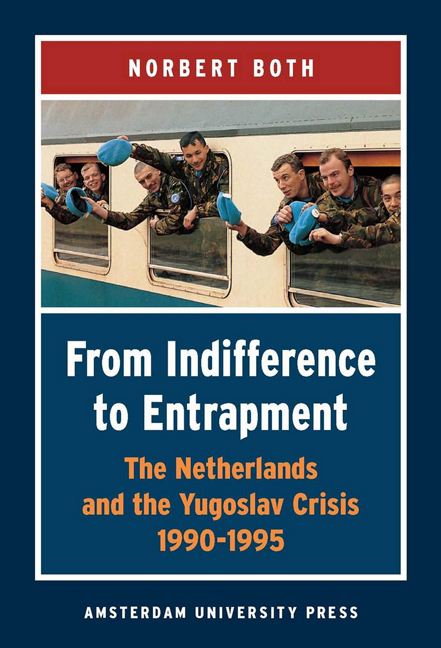Book contents
- Frontmatter
- Dedication
- Contents
- Preface
- Abbreviations
- Chronology
- Introduction
- 1 The Netherlands and its Foreign Policy System
- 2 An Emerging Challenge, July 1990 - June 1991
- 3 From ‘Even-Handedness’ to ‘Selectiveness’, July -December 1991
- 4 Moral and Political Entrapment: The Netherlands and International Peace Plans for Bosnia, 1992-1994
- 5 Military Entrapment: The Commitment to Srebrenica
- Conclusion
- Bibliography
- Index of Names
2 - An Emerging Challenge, July 1990 - June 1991
Published online by Cambridge University Press: 14 January 2021
- Frontmatter
- Dedication
- Contents
- Preface
- Abbreviations
- Chronology
- Introduction
- 1 The Netherlands and its Foreign Policy System
- 2 An Emerging Challenge, July 1990 - June 1991
- 3 From ‘Even-Handedness’ to ‘Selectiveness’, July -December 1991
- 4 Moral and Political Entrapment: The Netherlands and International Peace Plans for Bosnia, 1992-1994
- 5 Military Entrapment: The Commitment to Srebrenica
- Conclusion
- Bibliography
- Index of Names
Summary
By July 1990, Yugoslavia was in deep crisis, although most European governments did not notice it. In the various elections that had taken place in the individual Yugoslav republics during the second half of 1990, communists-turned-nationalists, or anti-communist nationalists had won overwhelming victories. ‘Yugoslavia no longer exists’, declared Slovene Foreign Minister Dimitrij Rupel in July 1990, having just been voted into power as part of the pro-independence coalition DEMOS. In the Serbian province of Kosovo, ethnic Albanians declared that Kosovo would no longer be a province in Serbia but one of the federation's constituent republics. Kosovo's autonomy had already been withdrawn by Serbian President Milosevic and the two Kosovar representatives purged from the federal Presidency. The year 1990 saw further purges of leading Albanians from their positions. Both Slovenia and Croatia demanded that Yugoslavia be restructured into a confederation of sovereign states. Croatian Serbs, in turn, declared that if Croatia were to become independent, they should be given the right to secede from Croatia and remain part of Yugoslavia. The Croatian government responded by sending its own special police into ethnically mixed Serb-Croat areas to replace the existing police. A violent incident between Croatian Serbs and Croats took place as early as September 1990 in the Croatian town of Glina, followed by shoot-outs in Pakrac and in Plitvice National Park in March 1991. In the meantime, various rounds of negotiations between the republics failed to produce reconciliation. A serious clash between Croatian policemen and Serb militiamen on May 2, 1991, in the Croatian village of Borovo Selo finally put the Yugoslav crisis on the international-political map. When Serbia subsequently blocked the regular rotation of the Yugoslav federal Presidency to the Croat Stipe Mesic (elected in 2000 as Croatian President on a reformist ticket), the Yugoslav crisis had become a serious foreign policy issue for Europe and America.
Turning to the international environment surrounding the Yugoslav crisis, one sees three organisations dominating the scene between July 1990 and June 1991. These were the CSCE (later: OSCE) through its principles and norms covering the relations between its member states, the EC (later: EU) through its European Political Cooperation (EPC), as well as NATO, through which the USA managed European security.
- Type
- Chapter
- Information
- From Indifference to EntrapmentThe Netherlands and the Yugoslav Crisis, 1990–1995, pp. 69 - 100Publisher: Amsterdam University PressPrint publication year: 2012



